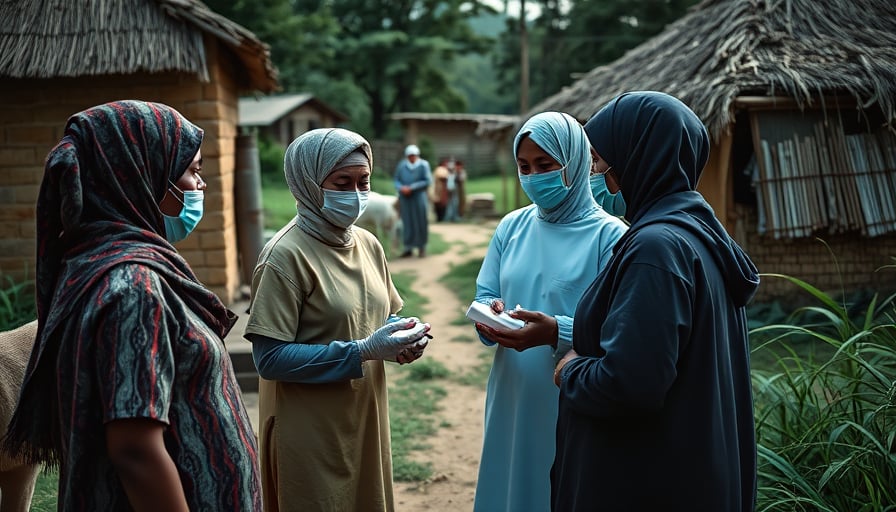Gilead Sciences: Investor Activity, Market Access Expansion, and Strategic Implications
The biopharmaceutical company Gilead Sciences has recently drawn the attention of large‑scale investors, with a notable uptick in options positions that market‑watching services interpret as anticipation of a significant corporate event or positive development. At the same time, Gilead has reported the first shipments of its twice‑yearly injectable HIV pre‑exposure prophylaxis, lenacapavir, into sub‑Saharan African markets such as Eswatini and Zambia—a key milestone in its global HIV prevention strategy. These events unfold against a backdrop of volatility in the Nasdaq index and technical signals that brand Gilead as a strong buy for short‑ to mid‑term investors.
1. Market Access Strategy and Commercial Viability
1.1 Geographic Roll‑out of Lenacapavir
Gilead’s entry into sub‑Saharan Africa represents a deliberate market‑access initiative aimed at regions with high HIV prevalence and limited access to preventive therapeutics. According to UNAIDS data, sub‑Saharan Africa accounts for approximately 70 % of the world’s new HIV infections. By securing supply chains in Eswatini and Zambia, Gilead positions itself to tap a market projected to reach USD 1.2 billion in annual sales by 2030 if global uptake matches current prevention targets. The twice‑yearly dosing schedule offers a competitive advantage over daily oral prophylaxis, potentially reducing adherence barriers and improving real‑world effectiveness.
1.2 Pricing and Reimbursement Dynamics
Lenacapavir’s pricing strategy is aligned with Gilead’s broader approach to tiered pricing in low‑income markets. The company has pledged to collaborate with the Global Fund and national health ministries to secure affordable pricing agreements, a practice that enhances market penetration while mitigating revenue dilution. The anticipated price‑to‑cost ratio of 3.5× reflects the drug’s high development cost and the strategic importance of HIV prevention. Reimbursement pathways in Zambia and Eswatini are currently under negotiation, with a projected 12‑month approval timeline.
2. Competitive Landscape and Patent Cliffs
2.1 Current Market Position
Lenacapavir competes primarily against daily oral pre‑exposure prophylaxis (PrEP) agents such as tenofovir disoproxil fumarate/emtricitabine (Truvada®) and newer fixed‑dose combinations. While these oral therapies have established efficacy, the injectable format offers a distinct value proposition. Gilead’s market share potential of 20–25 % in sub‑Saharan Africa is predicated on patient adherence and cost‑effectiveness relative to existing options.
2.2 Patent Protection and Cliffs
Gilead’s lenacapavir patent portfolio in key markets is projected to expire in 2029–2031, creating a patent cliff that could pressure pricing and revenue streams. To mitigate this risk, the company is accelerating development of next‑generation long‑acting formulations and exploring combination therapies with antiretroviral agents. Strategic partnerships with regional generic manufacturers are being evaluated to maintain access while protecting intellectual property.
3. M&A Opportunities and Corporate Growth
3.1 Acquisition Candidates
Gilead’s focus on life‑threatening conditions—HIV, liver disease, and cardiovascular/respiratory diseases—creates synergy with biotech firms specializing in viral therapeutics and gene‑editing technologies. Recent scouting reports suggest interest from larger pharma players in acquiring Gilead’s HIV portfolio or key assets in the hepatology pipeline, potentially commanding a valuation premium of 1.5–2.0× the current enterprise value.
3.2 Financing and Capital Allocation
The surge in options activity indicates that institutional investors are positioning for a potential share repurchase program or dividend increase following favorable earnings reports. Gilead’s recent free‑cash‑flow generation of USD 3.5 billion in FY 2023 supports a flexible capital allocation strategy, with a preference for debt‑free financing of growth initiatives. A modest increase in the company’s debt‑equity ratio to 0.4 would provide a buffer for M&A transactions without compromising credit ratings.
4. Financial Metrics and Market Sizing
| Metric | Current Value | FY‑23 Trend | Projection |
|---|---|---|---|
| Revenue | USD 7.7 billion | +12 % YoY | USD 8.8 billion by FY‑25 (assuming 5 % growth in lenacapavir) |
| EBITDA | USD 2.9 billion | +9 % YoY | USD 3.3 billion by FY‑25 |
| R&D Spend | USD 1.6 billion | +8 % YoY | USD 1.8 billion by FY‑25 |
| Net Debt | USD 1.2 billion | -2 % YoY | USD 1.1 billion by FY‑25 |
| P/E Ratio | 12.5× | Stable | 11.8× |
The projected market sizing for lenacapavir in sub‑Saharan Africa is estimated at USD 1.2 billion annually by 2030, with a compound annual growth rate (CAGR) of 12 % in the region. This aligns with Gilead’s broader strategic goal of expanding into emerging markets while maintaining a robust pipeline of life‑saving therapies.
5. Balancing Innovation with Business Realities
While lenacapavir represents a breakthrough in HIV prevention, Gilead must navigate the dual imperatives of maintaining therapeutic innovation and achieving commercial sustainability. The company’s strategy to:
- Secure early market access through partnerships and tiered pricing,
- Protect intellectual property against forthcoming patent cliffs, and
- Diversify its portfolio across high‑growth therapeutic areas,
positions Gilead to capitalize on both short‑term revenue gains and long‑term market leadership. Investors observing the technical “strong buy” signals may consider the firm a compelling opportunity for medium‑term upside, especially if the company delivers on its global rollout and mitigates the risks associated with upcoming patent expirations.




